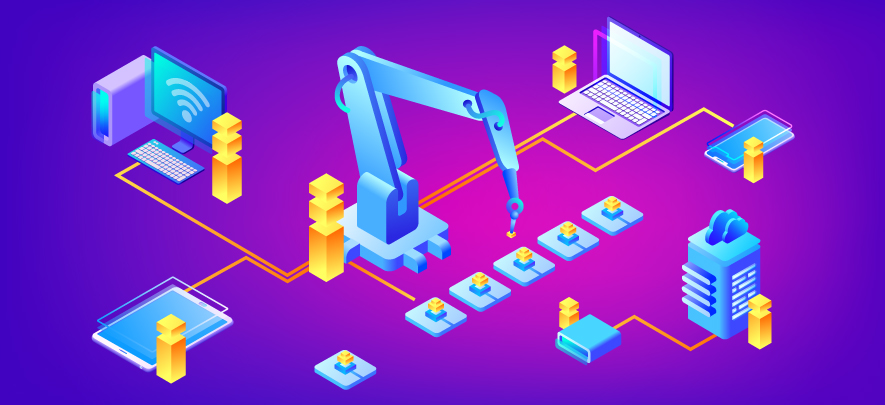Why Artificial Intelligence and IoT will revolutionise manufacturing and predictive maintenance

Digital & Technology
344 week ago — 6 min read
Summary: We are amid a digital and technological revolution that has an overarching impact on every aspect of our life. This is often referred to as the fourth Industrial Revolution – the first being the use of steam to mechanise production; the second was the use of electric power for mass production and the third the use of electronics and technology to automate production. Lester Fernandes shares how digital transformation through emerging technologies like Artificial Intelligence (AI) and Internet of Things (IoT) will completely revolutionise the manufacturing industry.
The fourth Industrial Revolution is already underway. And the best way to see digital transformation in progress is to take a closer look at the manufacturing/heavy machinery industry and the immediate impact on the ecosystem of connected services around it. Why is it that digital transformation within the manufacturing segment is likely to get more pervasive sooner rather than later?
Machine failure or downtime proves costly to manufacturing industry
The manufacturing industry is characterised by large and small equipment, typically running 24/7, and 365 days a year. Any major failure will typically result in a downtime, not only for production by the machine, but also in idle time for workers operating on that machine. When we talk about large utility equipment like trains, planes, power generators, etc. where end customers are also directly impacted, this leads to a further negative customer sentiment for the down time as well. The Shakespeare quote, ‘Better three hours too soon than a minute too late’, highlights the importance of predictive maintenance within the manufacturing industry.
Advantages of predictive maintenance to minimise downtime
Any prediction of timely maintenance or any downtime that can be prevented for equipment will greatly benefit the manufacturing industry and allow for happy end customers along with the resultant high productivity of the workers on the assembly line; and the predictability of the expected output from the machine. Combine this equipment monitoring data with further real time data from external sources like weather, regional, etc. and you have a system that can reasonably well predict any timely maintenance or upcoming downtime.
What is required to get these numerous advantages of predictive maintenance? The manufacturing industry has to equip itself with a variety of affordable sensors that can effectively monitor, measure, record and report values that are critical factors for determining the health of the machine. This internal data is relevant for monitoring and control along with any externally relevant sensor data. These are effectively channelled into a big data analyser that is trained with a Supervised Learning Model which in turn predicts with reasonable confidence what is likely to happen next. This simplistic model will only get built upon further to improvise into better solutions over time. Advent of 5G cellular technology with a lower latency time will enhance the speed of adoption and incorporation of new age technologies.
Artificial Intelligence (AI) and Internet of Things (IoT) to drive predictive maintenance
What is the infrastructure that will be necessary to generate this data, process it effectively and report/ dashboard/ action accordingly? It will require the relevant machine sensors combined in an Internet of Things (IoT) setup. The necessary external data (weather, order, financial) should then be coupled with the received sensor data within the cloud/ data lake to start training for reasonable monitoring predictions. This is possible by taking a snapshot of big data and combining it with the predictive analytics/ machine learning algorithms to get the desired results. The data can also be further refined for reporting engine/ dashboard purposes that will trigger any required corrective action – i.e. further automatic or manual intervention.
According to research from McKinsey & Co., AI-enhanced predictive maintenance of industrial equipment will generate a 10 percent reduction in annual maintenance costs, up to a 20 percent downtime reduction and 25 percent reduction in inspection costs. These gains are modest if you further factor in the non-tangible costs of customer satisfaction and image that will be presented to the customer.
According to another recent study by PricewaterhouseCoopers, 78 percent of manufacturing companies have deployed or are planning to deploy predictive maintenance technology; followed by 73 percent for manufacturing execution systems; 60 percent for digital twins; and 59 percent for robotic process automation.
Conclusion
To summarise, machine learning and advanced analytics today, play an important part in predictive maintenance and other operational aspects of the manufacturing process. This importance will only likely increase with time. AI enhanced Predictive Analytics with Machine Learning for manufacturing reduces annual maintenance costs, downtime and inspection costs. Only a shortage of relevant analytical skills, unified data and sharing standards are likely to slow down the ongoing revolution. It makes sense for the manufacturing industry to openly embrace Industrial Revolution 4.0 and start the digital transformation of their industry in anticipation of the future.
To explore business opportunities, link with me by clicking on the 'Invite' button on my eBiz Card.
Disclaimer: The views and opinions expressed in this article are those of the author and do not necessarily reflect the views, official policy or position of GlobalLinker.
Posted by
Lester Sebastiao FernandesI am looking to connect with other business owners who need to extract analytical insights from current data and take informed decisions. We make your Data Insights journey easier...
View Lester 's profile
SME Inspirations
Other articles written by Lester Fernandes
Technology & business trends: 2019 & beyond
341 week ago
Most read this week
Trending
What is BRC in Export Business?
Export Sector 1 week ago














Comments
Share this content
Please login or Register to join the discussion